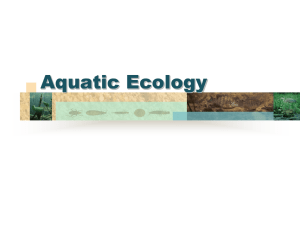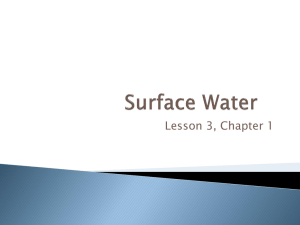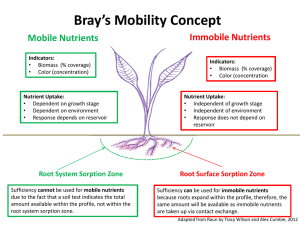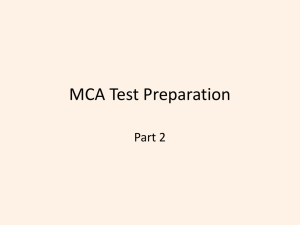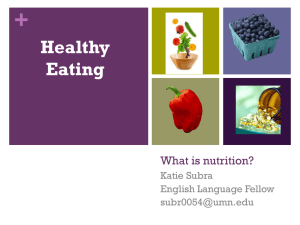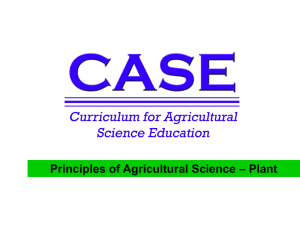Aquatic Ecology 101
advertisement
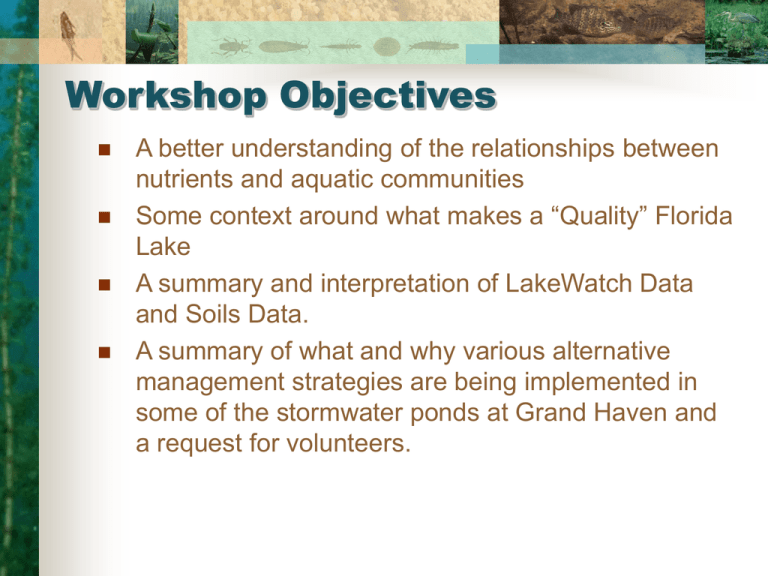
Workshop Objectives A better understanding of the relationships between nutrients and aquatic communities Some context around what makes a “Quality” Florida Lake A summary and interpretation of LakeWatch Data and Soils Data. A summary of what and why various alternative management strategies are being implemented in some of the stormwater ponds at Grand Haven and a request for volunteers. Agenda Presentation - Aquatic Ecology 101 Video - What Makes a Quality Lake? Break Presentation - Watershed Connections Data summary – LakeWatch Data Data Summary - Soils Data Presentation – Alternative management practices and why they are being evaluated Monitoring plan Aquatic Ecology 101 Mark Clark Extension Specialist Wetlands and Water Quality Soil and Water Science Department University of Florida Outline Types of aquatic ecosystems Hydrology of lakes and ponds Lake zones and processes Aquatic food web Lake trophic states Concept of limiting nutrient Types of Aquatic Systems Rivers & Streams Lakes & Ponds Wetlands Estuaries Groundwater Marine system Lakes and Ponds Critical differences from other freshwater systems Longer residence time Typically not shaded with most of the surface area exposed to sunlight Florida lakes are typically shallow and well mixed Florida lakes are often highly colored, but can have light reaching much of the bottom Photo by Bill Wade Watershed / Lake Area Ratio Watershed area relative to lake area will influence the residence time of water in the lake. This ratio is also a factor in the nutrient loading to the lake Lake Habitat Zones Lake Littoral Zone Functions Intercepts Nutrients Refuge from Predators Nursery for Fish Oligotrophic Northern Lake Eutrophic Southern Lake Lake Limnetic/Pelagic Zone Functions Plankton Zooplankton Lake Limnetic / Pelagic Zone Submerged Aquatic Vegetation (SAV) Nutrient uptake Sediment stabilization Habitat Oxygen production Pond Food Web Algae/Plants Fish Nutrients Grazers Nutrients Algae/Plants Grazers Fish Relationship Between Nutrients and Pond Productivity Nutrients Nutrients Algae/Plants Grazers Algae/Plants Grazers Nutrients Algae/Plants Nutrients Algae/Plants Nutrients Algae/Plants Grazers Grazers Grazers Fish Fish Fish Fish Fish Habitat/Environmental Impacts Low nutrients Low primary productivity Low grazers and insects Low fish production Clear water Sandy/low organic matter on bottom Moderate nutrients TROPHIC STATE Increased primary productivity More grazers and insects More fish production Moderate water clarity More aquatic plants Some organic sediment accumulation HighTROPHIC nutrients STATE High primary productivity Large number of grazers and insects Moderate fish production Low water clarity, or Clear with aquatic plants High organic sediment accumulation Trophic State Change Nutrients & Productivity Sediment & Accumulation Species Shifts Species Richness Manipulating Pond Response to Nutrients Source of the problem Nutrients X Algae/Plants Grazers Grazers Fish Fish Limiting Nutrient Concept …Plants need nutrients to grow Nitrogen and Phosphorus are the main nutrients For every unit of N you need so many units of P If one nutrient is not in sufficient supply it will limit the total production potential. For algae N:P > 17 Phosphorus Limited N:P < 10 Nitrogen Limited 10 < N:P < 17 Co-Limitation N:P < 22 will tend to promote Cyanobacteria which are nitrogen fixers Phosphorus Limitation: Lake 227 Total Phosphorus / Chlorophyll-a Relationship Phosphorus is typically liming nutrient in freshwater Nitrogen is typically limiting nutrient in marine system. Summary Lakes have longer residence time and more light than other freshwater systems Littoral Zone, Pelagic Zone, Submerged Aquatic Vegetation Nutrients regulate algae > grazers > fish Removing algae doesn’t remove nutrient regulator Phosphorus is typical nutrient limiting nutrients depending on N:P ratio Stormwater ponds respond just like lakes do to nutrients Questions?
